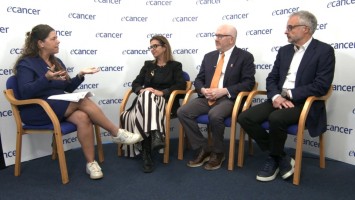ESGO 2013
Results of the ICON7, phase III clinical trial
Prof Eric Pujade-Lauraine - Université de Paris Descartes, France
Eric, you’ve just been talking about some very interesting results because bevacizumab has had a chequered history, it’s very good for some things, it’s been a disappointment in others. Tell me what you’ve been doing in the ICON7 study.
The ICON7 study was evaluating bev in first line treatment of ovarian cancer with a very wide scope of stage. The final results on PFS and overall survival showed that, indeed, in patients which are called in the high risk group, and I will tell a bit more later, there is a very significant advantage for adding bev to chemotherapy and using it in maintenance in PFS and, and this is very important, in overall survival.
Now, you had to break it down into the different prognostic groups, didn’t you?
Yes, that’s right.
And there was quite a big difference. How did the patients break down, how many were in the low risk and how many in the high risk?
Two-thirds were in the low risk, one third were in the high risk. So what is the high risk patient? The high risk patients are the patients who failed to achieve a complete resection with initial surgery, so all those who are inoperable, those who have microscopic residue after any surgery and those also who are stage 4. All these patients benefit significantly from the addition of bev.
What did you find about progression free survival earlier? Was it becoming clear that there was an advantage earlier on in ICON7?
It depends if you take into account the whole population and there, obviously, those patients who are early stage or completely resected do not benefit and they are the majority of the patients. When you look at the entire population you don’t see any very big difference except a difference in PFS which is quite small in the entire population. And this is mainly in the high risk population that you see a very significant and big difference, which is clinically meaningful though.
And how significant is that? The curves were well apart, weren’t they?
Yes. In the overall survival, for instance, which is the final endpoint that everybody would like to achieve, there is a nine month difference from 30 months to 39 months for patients treated with bev. So that should be very convincing people to use bev in this subset of patients.
That doesn’t suggest, then, that you should also use it in other patients?
Well there it should be discussed case by case in a multidisciplinary meeting because we lack sufficient data to be sure that the patients will benefit from bev.
In which case, of course, if it was used in other cases of ovarian cancer then in fact you could have a toxicity problem. What did you run up against?
You should be aware that bev has the approval in patients with stage 3A/B, 3C and 4, whatever the residue. So it’s in line with the label to use it in patients with complete resection but the data we have shown suggested we should discuss it case by case to see what is the best benefit to risk ratio.
And what toxicities did you find, though?
The toxicity of bev is very well known, that was specific new information. It’s an increase in the hypertension, proteinuria, so you must monitor blood pressure very carefully. There was a very small increased rate of thrombosis.
So what, finally, can you say is the message that doctors should take home from these results from ICON7?
In the patients where the skilled surgeon cannot achieve complete resection, propose chemotherapy and bev.
Thank you very much indeed.
Thank you.








